初中英语强化训练_777
- 格式:doc
- 大小:74.50 KB
- 文档页数:9
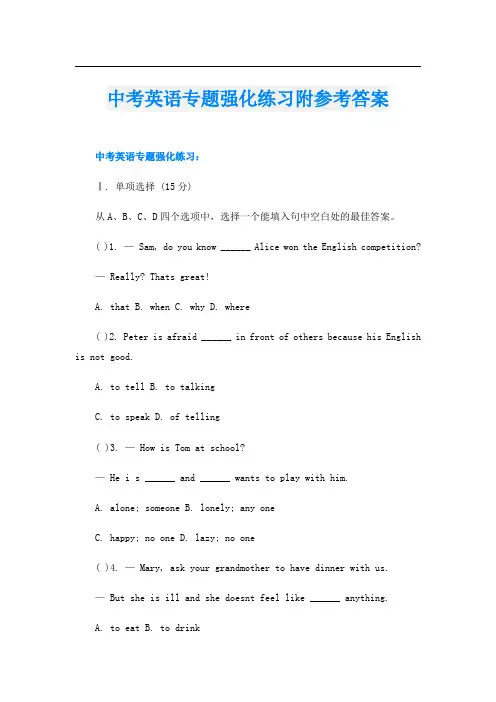
中考英语专题强化练习附参考答案中考英语专题强化练习:Ⅰ. 单项选择 (15分)从A、B、C、D四个选项中,选择一个能填入句中空白处的最佳答案。
( )1. — Sam, do you know ______ Alice won the English competition?— Really? Thats great!A. thatB. whenC. whyD. where( )2. Peter is afraid ______ in front of others because his English is not good.A. to tellB. to talkingC. to speakD. of telling( )3. — How is Tom at school?— He i s ______ and ______ wants to play with him.A. alone; someoneB. lonely; any oneC. happy; no oneD. lazy; no one( )4. — Mary, ask your grandmother to have dinner with us.— But she is ill and she doesnt feel like ______ anything.A. to eatB. to drinkC. eatingD. drinking( )5. — Tom, do you know David Smith?— Sure. He is my best friend and our ______ has lasted for years.A. activitiesB. friendshipC. recordingD. hobbies( ) 6. It will you about thirteen hours to fly to England from Hong Kong.A . spend B. take C. use D. pay( ) 7. My father has me the ending of the football game.A. told; withB. tell; aboutC. tell; withD. told; about( ) 8. I dont like the bag. Please give me a better .A. oneB. onesC. itD. them( ) 9. Mr Wang bought a small cat my sister.A. toB. forC. ofD. in( )10. Ive done my homework. But I havent cleaned the car .A. alreadyB. justC. neverD. yet( )11. — Did the singing star agree to come?— Yes, but Im not sure ______ or not he will come on time.A. whetherB. ifC. whenD. where( )12. I remembered ______ my homework last night, but I cant find it now.A. to finishB. finishingC. checkD. to check( )13. — Linda, I will have an English test on Wednesday.— ______A. Good luck!B. Excuse me.C. Hold the line.D. Look out!( )14. — I heard you won first prize in the match. Did your parents know that?— No, I will tell them ______.A. at that momentB. just nowC. right nowD. just then( )15. — Im very tired these days because of studying chemistry.— Why not listen to music? It can make you ______.A. beautifulB. boringC. funnyD. relaxedⅡ. 完形填空 (10分)先通读下列短文,掌握其大意,然后从每题所给的四个选项中选择最佳答案填空。
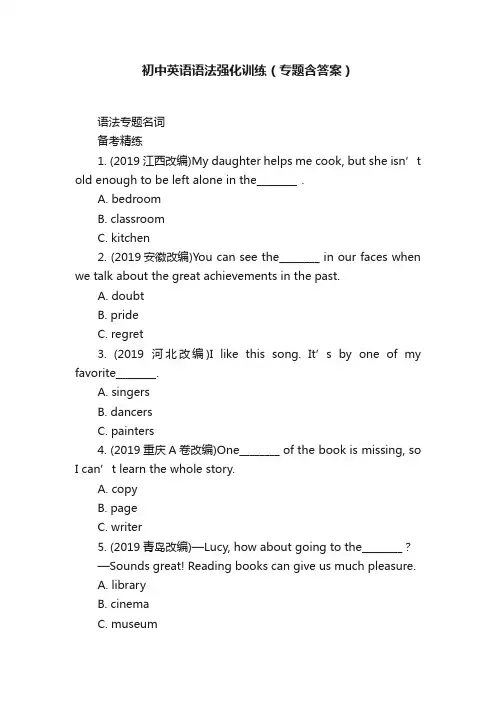
初中英语语法强化训练(专题含答案)语法专题名词备考精练1. (2019江西改编)My daughter helps me cook, but she isn’t old enough to be left alone in the________.A. bedroomB. classroomC. kitchen2. (2019安徽改编)You can see the________ in our faces when we talk about the great achievements in the past.A. doubtB. prideC. regret3. (2019河北改编)I like this song. It’s by one of my favorite________.A. singersB. dancersC. painters4. (2019重庆A卷改编)One________ of the book is missing, soI can’t learn the whole story.A. copyB. pageC. writer5. (2019青岛改编)—Lucy, how about going to the________?—Sounds great! Reading books can give us much pleasure.A. libraryB. cinemaC. museum6. (2019连云港改编)On April 24, Xie Wenjun raced to gold in the________ 110-meter hurdles at the Asian Athletics Championships in Qatar.A. manB. menC. men’s7. (2019东营改编)It’s not a good________ for students to go online just for answers to homework.A. skillB. hobbyC. habit8. (2019长沙雅礼中学模拟)—Uncle, how far is your company from your home?—It’s about ________ walk.A. ten-minuteB. ten minutesC. ten minutes’9. (2020原创)—What’s the ________ of your excellent driving skill?—Practice makes perfect.A. speedB. giftC. secret10. (2020原创) Every coin has two________. Becoming a famous player is cool but it needs a great amount of hard work.A. roomsB. pointsC. sides11. (2020原创)The old man takes good ________ of his dog and regards it as his friend.A. careB. prideC. life12. (2020原创)Tina’s father is o n________ in Shanghai recently and Tina misses him very much.A. interestB. businessC. fun13. (2020原创)Here we would like to invite you to join us and share your ________ and photos with us.A. storyB. storiesC. storys14. (2020原创)I want to buy ________ for my son. He really likes it.A. two bottle of milkB. two bottle of milksC. two bottles of milk15. (2020原创)In order to make our school life more colorful, more activities and ________ will be held in our school.A. experienceB. competitionC. competitions16. (2020原创)________ Day is coming and I’m wondering what to get for my father.A. Father’sB. Fathers’C. Father17. (2020原创)Though the little boy is young, he can dress himself without his ________ help.A. mother’sB. mothersC. mother18. (2020原创)This is ________ English teacher. She is kind and patient.A. Lily’s and Lucy’sB. Lily and Lucy’sC. Lily’s and Lucy挑战题19. 陷阱题The mobile phone sells for 5,000 yuan, and it is much more than its real ________.A. costB. valueC. money20. 陷阱题—Are you going out with Jade tonight?—That’s my________. Mind your own!A. offerB. businessC. question21. 陷阱题The three ________ upstairs are too small to have enough ________ for a double bed.A. room, roomB. room, roomsC. rooms, room冠词1. (2019广东改编)________ Great Wall is one of the seven wonders around the world.A. TheB. AC. /2. (2019甘肃省卷改编)Lily practices playing __________ violin after school every day.A. aB. anC. the3. (2019天水改编)—You’ve dropped ________“s” in the word “necessary”.—Oh, the letter “s” is doubled.A. aB. anC. the4. (2019淮安改编)T o save time, many students have ________ lunch at school every day.A. aB. anC. /5. (2019咸宁改编)—Do you know 2019 is the year of the Pig?—Sure. The pig is________ twelfth sign in the Chinese zodiac cycle(生肖).A. aB. anC. the6. (2018湘潭) I have ________ eight-month-old sister and she is very lovely.A. aB. anC. the7. (2017岳阳)—Ben, is physics your favorite subject?—Yes, and it is ________ important one.A. aB. theC. an8. (2019长沙四模)Hurry up! The concert will begin in ________ minute.A. aB. /C. the9. (2019长沙三模)—The task is too difficult for me to finish.—Don’t worry.I’ll give you________ hand.A. aB. theC. /10. (2020原创)—Gina, it’s going to r ain. Take ________ umbrella to school with you.—OK, Mom.A. aB. anC. the11. (2020原创)Paper-cutting is a traditional art of China. Many foreigners have ________interest in it.A. aB. anC. /12. (2019原创)This street is ________ one-way street. Many people hope it will be changed into two-way traffic.A. aB. anC. /13. (2019原创)—T ony,can you make ________ sentence with “have nothing against”?—No problem. It’s a piece of cake.A. /B. aC. an14. (2020原创)The bridge between the two islands is ________ longest one in this area.A. aB. anC. the15. (2020原创)The new study shows that going to ________ bed late is harmful to our health.A. /B. anC. the用冠词a/an/the填空1. (2019广东改编)We all know that ________ Great Wall is one of the seven wonders around the world.2. (2019兰州改编)Hide-and-seek is________ interesting game for children.3. (2019滨州改编)Song of Youth is such________ fantastic film that I have seen it twice.4. (2019青岛改编)Qingdao is a beautiful city that lies in ________ east of China.5. (2019凉山州改编)Laura is an 11-year-old girl. She is good at playing ________ guitar.6. (2019天水改编)You’ve dropped ________ “s” in the word “necessary”. How careless you are!7. (2019怀化改编)They often have three meals ________ day. They have dinner at 6:30 pm every day.8. (2020原创)Compared to writing by hand, using ________computer can correct mistakes more easily.9. (2020原创)We are talking about ________ boy we met at the restaurant last night.10. (2020原创)Longman Dictionary is ________ useful tool for English learners.11. (2020原创)He likes watching the fifth channel. ________ channel is about sports.12. (2020原创)I usually have a piece of bread and ________ egg for breakfast.13. (2020原创)There is ________ knife and fork on this table. Please bring a set.14. (2020原创)Our family lives next door to ________ Simpsons.I have known their son for a long time.15. (2020原创)I meet my foreign friend twice________ week ina coffee shop to practice my English.16. (2020原创)Read through ________ article on Page 25 and fill in the chart below.17. (2020原创)This park would be a good place for our class to have ________ picnic.18. (2020原创)It is not ________ good idea to drive for four hours without a break.19. (2020原创)I usually take ________ shower before going to school in the morning.形容词和副词备考精练1. (2019菏泽)Be more________ next time, and you won’t make the same mistake again.A. carelessB. carefulC. nervous2. (2019北京改编)Julie takes good care of the family dog. She is ________ than her brother.A. patientB. more patientC. most patient3. (2019广东改编)Fishing is one of ________ activities among the middle-aged people.A. popularB. more popularC. the most popular4. (2019天津改编)—Diana, I forget new words quickly. How can I remember them?—Don’t worry. It’s ________ to forget new words! I suggest you reading the words and trying to use them.A. naturalB. excitingC. perfect5. (2019重庆A卷改编)Nobody worked the math problem out. It was________ one of all.A. difficultB. more difficultC. the most difficult6. (2019重庆B卷改编)Lisa made so many mistakes in her homework, b ecause she didn’t do it ________ enough.A. carefullyB. busilyC. quickly7. (2019南京改编)Seeing the new changes in her hometown, Nanjing, Sandy could________ believe her eyes.A. hardlyB. highlyC. nearly8. (2019甘肃省卷改编)Sam is 11 years old. Peter is 16 years old. Peter is 5 years________ than Sam.A. olderB. shorterC. newer9. (2019青岛改编)To make rivers________ than before, everybody is supposed to protect them.A. cleanerB. cleanestC. the cleaner10. (2019盐城改编)________ say that English is too difficult for us to learn. We can learn it well with efforts.A. SometimesB. SeldomC. Never11. (2019鄂州改编)—Paul, do you prefer weekdays or weekends?—Weekdays, of course. I’m ________ on weeken ds.A. busyB. much busierC. more busier12. (2019扬州改编)—Tan Dun does not use any musical instruments in his music Water.—That’s really ________!He is so creative.A. boringB. amazedC. amazing13. (2019襄阳改编)Tom runs________ in our class. None of uscan catch him in the race.A. fastB. fasterC. the fastest14. (2019长沙三模)—What do you think of your English teacher?—She is great.No one teaches ________ in our school.A. wellB. betterC. best15. (2019长沙雅礼中学模拟)Health is on the top of my list. Nothing is ________.A. importantB. more importantC. the most important16. (2019长沙黑白卷)—I can hardly see the words on the screen.—Well, let’s go and take the front seats so that we may see them________.A. clearlyB. more clearlyC. most clearly17. (2020原创)It’s ________ for us to offer helping hands to people who are in trouble.A. necessaryB. uselessC. terrible18. (2020原创)You’d better keep the window ________. It’s raining heavily outside.A. openC. free19. (2020原创)Our teacher is ________ with us in class but kind after school.A. strictB. hardC. rude20. (2020原创)The population of China is much ________ than that of Russia.A. smallerB. largerC. fewer21. (2020原创) If you’re really ________,you need to tak e a rest and relax yourself, and don’t keep studying all the time.A. worriedB. hungryC. tired22. (2020原创)When a problem appears, we should look fora ________ way to solve it instead of asking others for help at once.A. differentB. correctC. wrong23. (2020原创) Letting others feel ________ to talk with you is the basic secret to communicating with them well.A. comfortableB. upsetC. sure24. (2020原创)It’s a ________ day today. Let’s fly a kite in the park.A. sunnyC. rainy25. (2020原创)—He hardly had friends because he used to be mean.—But now he has changed a lot. He treats others ________ and becomes popular.A. nicelyB. rudelyC. heavily26. (2020原创)Though Tom isn’t so ________ as John, he works hard to catch up with him.A. cleverB. more cleverC. most clever27. (2020原创)My father thinks the fried food is not good for health, so he ________ eats it.A. alwaysB. seldomC. often28. (2020原创)—I have trouble reading such a long passage.—You can read ________ t o get the main idea first. Don’t read word by word. Just read for the key points.A. recentlyB. mainlyC. quickly29. (2020原创)They picked as ________ apples as the farmers did and this surprised me.A. manyB. moreC. most30. (2020原创)The________ you start, the sooner you’ll be back.A. earlyB. earlierC. earliest31. (2020原创)Friends mean a lot to me. I always feel much ________ after I tell my problems to my close friends.A. goodB. better D. best32. (2020原创)—We may move to another planet in the future with the population increasing.—I think so. We will have no other choices if it gets a lot ________.A. largeB. largerC. largest33. (2020原创)It’s hard to hold back the tears. This is ________ thing I’ve ever heard.A. sadB. sadderC. the saddest34. (2020原创)—The scarves are all beautiful. I can’t decide which one to buy.—Oh, look at this red one. I think it’s ________.A. beautifulB. more beautifulC. the most beautiful35. (2020原创)Lucy is ________ student in our class. She often answers the teachers’ questions in class.A. activeB. more activeC. the most active36. (2020原创)—Is the boy’s house ten miles away from the school?—Yes. He lives________ in his class.A. farB. fartherC. farthest37. (2020原创)The seats in the middle of the cinema are the ________ of all. We can have a good view there.A. goodB. betterC. best38. (2020原创)You should do your homework as ________ as possible, so that you can make fewer mistakes.A. carefullyB. more carefullyC. most carefully39. (2020原创)Jenny speaks English as ________ as Tom and they often practice spoken English together.A. wellB. betterC. best40. (2020原创)He solved the problem ________ of the three men.A. the most directlyB. directlyC. more directly挑战题41. 陷阱题(2019江西改编)—What do you think of the band’sperformance?—It could be ________. I think they’re feeling very nervous.A. goodB. betterC. worse42. 陷阱题Aunt Jane is now ________ over seventy, but she is still a great cinema-goer.A. veryB. wellC. quite43. 陷阱题—Jimmy, where are my glasses? I have looked for it everywhere.—Oh, Granny. They are ________ on your nose.A. evenB. wellC. right44. 陷阱题Bob is growing fast. He is________ taller than his mother.A. farB. quiteC. very代词备考精练1. (2019哈尔滨)Learning is a lifelong journey because we can learn ________ every day.A. nothing newB. new somethingC. something new2. (2019北京改编)Mr.Wang is coming to our school. I can’t wait to see ________.A. herB. himC. it3. (2019河北改编)—My ruler is broken. Can I borrow ________?—Of course. Here it is.A. hisB. hersC. yours4. (2019安徽改编)Could you stay a little longer? I have________ more to tell you about the plan for tomorrow.A. somethingB. everythingC. anything5. (2019甘肃省卷改编)Sunny’s uncle is a teacher. ________ enjoys staying with kids.A. HeB. SheC. I6. (2019云南改编)—________ sport will you take part in, Peter?—The boys’ 800-meter race.A. WhereB. WhenC. Which7. (2019遂宁改编)The baby is too young. Don’t leave her at home by________.A. sheB. herC. herself8. (2019淮安改编)Some people are too shy to say a word in public. However,________ aren’t.A. othersB. the otherC. the others9. (2019常州改编)—When would you like to go swimming with me, this Friday or this Saturday?—________. I am free only this Sunday.A. NoneB. EitherC. Neither10. (2019长沙师大附中模拟)—Excuse me, John, but which is for me?—You can take ________ half. They are exactly the same.A. neitherB. anyC. either11. (2019长沙雅礼中学模拟)Johnson was asked a lot of questions, but he didn’t answer ________ of them.A. otherB. anyC. some12. (2019长沙长郡中学模拟)I’m growing up, but I find ________ more and more difficult to make my own decisions.A. thisB. itC. that13. (2019长沙黑白卷)—I’m sorry I took your English book by mistake. But where is ________?—Don’t worry. I will help you find it.A. meB. myC. mine14. (2020原创)Everyone makes mistakes in his or her life. The important thing is not to repeat ________.A. itB. themC. him15. (2020原创)If we just think about ________,the boat of friendship will be overturned anytime.A. myselfB. himselfC. ourselves16. (2020原创)Finally, they reached an agreement on their business which made ________ parties pleased.A. bothB. noneC. most17. (2020原创)To get the main idea of this passage, you can read the first sentence of ________ paragraph.A. eitherB. everyC. each18. (2020原创)—________ can I do to make progress in English listening?—Listen to some English songs and watch English movies.A. WhereB. WhoseC. What19. (2020原创)Many people in Canada speak French but their French is very different from ________ of France.A. oneB. itC. that20. (2020原创)________ is important for us to have a balanced diet and enough sleep.A. ItB. ThatC. This挑战题21. 陷阱题(2019无锡改编)If something is wrong, fix it if you can. Do not worry. Worry never fixes ________.A. somethingB. everythingC. anything22. 陷阱题—How many apples can I have?—You can have two.________ are for Jim.A. The othersB. OthersC. The other23. 陷阱题He didn’t make ________ clear when and where the meeting would be held.A. thisB. thatC. it数词1. (2019湘西)—How many books are there on the shelf?—Well. I think there are ________ books.A. two hundred and forty-sixB. two hundreds and fortyC. two hundred fourteen2. (2019广东改编)We are proud of our country. The year 2019is her ________ birthday.A. seventyB. the seventyC. seventieth3. (2019甘肃省卷)September is the ________ month of a year.A. seventhB. eighthC. ninth4. (2019苏州改编)He seems to have a ________ sense for knowing that his brother will win.A. oneB. the firstC. sixth5. (2016怀化)During the May Day holiday, ________ visitors came to Zhijiang to visit the Memorial Hall of Flying Tigers.A. thousand ofB. thousandsC. thousands of6. (2019长沙三模)—Can you finish the work on time?—Hard to say.I think we need another ________ men.A. thirdB. the thirdC. three7. (2020原创)About ________ fans are waiting here. They want to see the great singer.A. two thousandsB. two thousandC. two thousands of参考答案名词1.C2. B3. A4. B5. A6. C7. C8. C9. C10. C11. A12. B13. B14. C15. C16. A17. A18. B19. B20. B21. C冠词1. A2. C3. B4. C5. C6. B7. C8. A9. A10. B11. B12. A13. B14. C15. A1. the2. an3. a4. the5. the6. an7. a8. a9. the10. a11. The12. an13. a14. the 15. a 16. the17. a18. a19. a形容词和副词1.B2. B3. C4. A5. C6. A7. A8. A9. A10. C11.B12. C13. C14. B15. B16. B17. A18. B19. A20. B 21.C22. B23. A24. A25. A26. A27. B28. C29. A30. B 31.B32. B33. C34. C35. C36. C37. C38. A39. A40. A 41. B42. B43. C44. A代词1.C2. B3. C4. A5. A6. C7. C8. A9. C10. C11.B12. B13. C14. B15. C 16. A17. C18. C19. C20. A 21. C22. A23. C数词1. A2. C3. C4. C5. C6. C7. B。
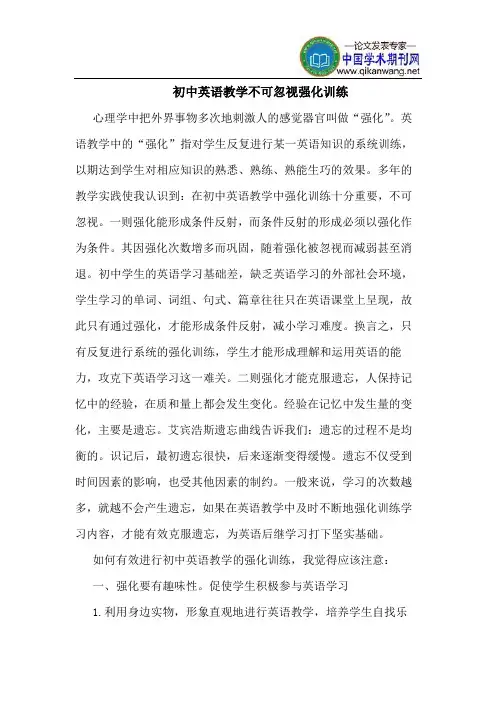
初中英语教学不可忽视强化训练心理学中把外界事物多次地刺激人的感觉器官叫做“强化”。
英语教学中的“强化”指对学生反复进行某一英语知识的系统训练,以期达到学生对相应知识的熟悉、熟练、熟能生巧的效果。
多年的教学实践使我认识到:在初中英语教学中强化训练十分重要,不可忽视。
一则强化能形成条件反射,而条件反射的形成必须以强化作为条件。
其因强化次数增多而巩固,随着强化被忽视而减弱甚至消退。
初中学生的英语学习基础差,缺乏英语学习的外部社会环境,学生学习的单词、词组、句式、篇章往往只在英语课堂上呈现,故此只有通过强化,才能形成条件反射,减小学习难度。
换言之,只有反复进行系统的强化训练,学生才能形成理解和运用英语的能力,攻克下英语学习这一难关。
二则强化才能克服遗忘,人保持记忆中的经验,在质和量上都会发生变化。
经验在记忆中发生量的变化,主要是遗忘。
艾宾浩斯遗忘曲线告诉我们:遗忘的过程不是均衡的。
识记后,最初遗忘很快,后来逐渐变得缓慢。
遗忘不仅受到时间因素的影响,也受其他因素的制约。
一般来说,学习的次数越多,就越不会产生遗忘,如果在英语教学中及时不断地强化训练学习内容,才能有效克服遗忘,为英语后继学习打下坚实基础。
如何有效进行初中英语教学的强化训练,我觉得应该注意:一、强化要有趣味性。
促使学生积极参与英语学习1.利用身边实物,形象直观地进行英语教学,培养学生自找乐趣特别是初学英语的学生,让他们从身边的直观的如电视机、收录机、文具用品、课桌来学习英语,往往能激发他们的英语学习兴趣。
比如在教学“铅笔”和“钢笔”这两个单词时。
教师指着—个学生课桌上的钢笔说:this is a pen,又拿出一支铅笔说:that is apencil,接下来才让学生进行“pen”和“pencil”这两个单词的学习,学生有了之前的直观感受,在大脑中有了“强化”,就十分容易记住这两个单词。
由于是学生的身边物品,学生之间也能在课外随时反复强化,增加英语学习的趣味性。
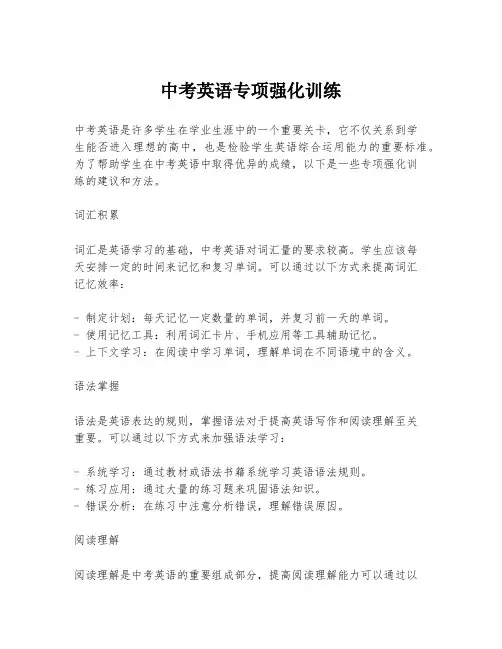
中考英语专项强化训练中考英语是许多学生在学业生涯中的一个重要关卡,它不仅关系到学生能否进入理想的高中,也是检验学生英语综合运用能力的重要标准。
为了帮助学生在中考英语中取得优异的成绩,以下是一些专项强化训练的建议和方法。
词汇积累词汇是英语学习的基础,中考英语对词汇量的要求较高。
学生应该每天安排一定的时间来记忆和复习单词。
可以通过以下方式来提高词汇记忆效率:- 制定计划:每天记忆一定数量的单词,并复习前一天的单词。
- 使用记忆工具:利用词汇卡片、手机应用等工具辅助记忆。
- 上下文学习:在阅读中学习单词,理解单词在不同语境中的含义。
语法掌握语法是英语表达的规则,掌握语法对于提高英语写作和阅读理解至关重要。
可以通过以下方式来加强语法学习:- 系统学习:通过教材或语法书籍系统学习英语语法规则。
- 练习应用:通过大量的练习题来巩固语法知识。
- 错误分析:在练习中注意分析错误,理解错误原因。
阅读理解阅读理解是中考英语的重要组成部分,提高阅读理解能力可以通过以下方法:- 广泛阅读:阅读不同类型的英文材料,如小说、报纸、杂志等。
- 提高速度:练习快速阅读并理解文章的主旨大意。
- 培养技巧:学习并运用扫读、略读等阅读技巧。
写作能力写作是检验学生英语综合运用能力的重要方式。
提高写作能力可以通过以下途径:- 模仿练习:模仿优秀范文,学习其结构和表达方式。
- 定期写作:每周至少完成一篇英语写作练习。
- 获取反馈:向老师或同学寻求写作反馈,不断改进。
听力训练听力理解是中考英语的另一个关键部分。
提高听力可以通过以下方法:- 日常听力:利用英语歌曲、电影、播客等资源进行听力训练。
- 专项练习:使用中考英语听力练习材料,模拟考试环境。
- 注意细节:在听力练习中注意捕捉细节信息,提高理解能力。
口语表达虽然口语不是中考英语的直接考核内容,但良好的口语能力有助于提高学生的英语思维和表达能力。
可以通过以下方式来提高口语:- 参与对话:与同学或老师进行英语对话练习。
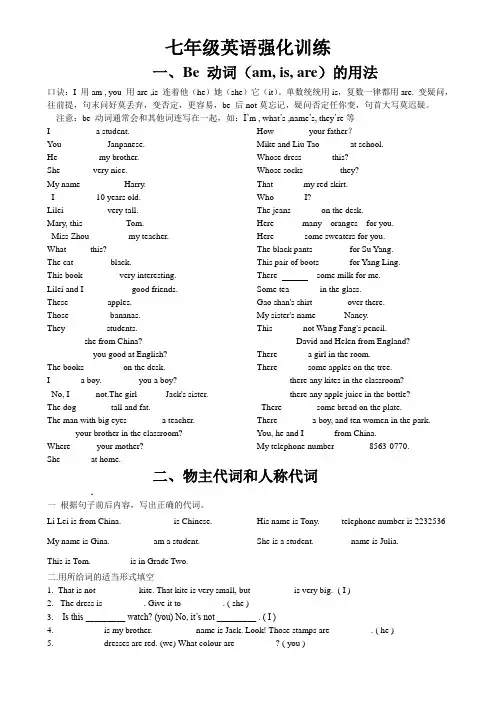
七年级英语强化训练一、Be 动词(am, is, are)的用法口诀:I 用am , you 用are ,is 连着他(he)她(she)它(it)。
单数统统用is,复数一律都用are. 变疑问,往前提,句末问好莫丢弃,变否定,更容易,be 后not莫忘记,疑问否定任你变,句首大写莫迟疑。
注意:be 动词通常会和其他词连写在一起,如:I’m , what’s ,name’s, they’re等I ________ a student.Y ou ________ Janpanese.He _______ my brother.She_______ very nice.My name ________Harry.I _______ 10 years old.Lilei _________ very tall.Mary, this _________ Tom.Miss Zhou ________ my teacher.What_____ this?The cat________ black.This book________ very interesting.Lilei and I __________ good friends.These ________ apples.Those_________ bananas.They _________students.________ she from China?________ you good at English?The books ________ on the desk.I ______ a boy. ______ you a boy?No, I _____ not.The girl______ Jack's sister. The dog _______ tall and fat.The man with big eyes _______ a teacher.______ your brother in the classroom? Where _____ your mother?She ______ at home. How _______ your father?Mike and Liu Tao ______ at school.Whose dress ______ this?Whose socks ______ they?That ______ my red skirt.Who ______ I?The jeans ______ on the desk.Here ______many oranges for you.Here ______ some sweaters for you.The black pants ______ for Su Y ang.This pair of boots ______ for Y ang Ling.There some milk for me.Some tea ______ in the glass.Gao shan's shirt _______ over there.My sister's name ______Nancy.This ______ not Wang Fang's pencil.______ David and Helen from England? There ______ a girl in the room.There ______ some apples on the tree._______ there any kites in the classroom?_______ there any apple juice in the bottle? There _______ some bread on the plate.There _______ a boy, and ten women in the park. Y ou, he and I ______ from China.My telephone number________8563-0770.二、物主代词和人称代词.一根据句子前后内容,写出正确的代词。
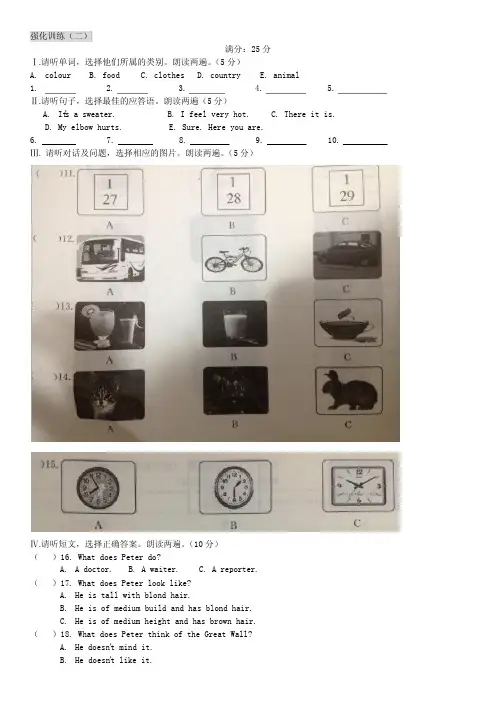
强化训练(二)满分:25分Ⅰ.请听单词,选择他们所属的类别。
朗读两遍。
(5分)A.colourB. foodC. clothesD. countryE. animal1. 2. 3. 4. 5. Ⅱ.请听句子,选择最佳的应答语。
朗读两遍(5分)A.It’s a sweater.C. There it is.B. I feel very hot.E. Sure. Here you are.D. My elbow hurts.6. 7. 8. 9. 10. Ⅲ. 请听对话及问题,选择相应的图片。
朗读两遍。
(5分)Ⅳ.请听短文,选择正确答案。
朗读两遍。
(10分)( )16. What does Peter do?C. A reporter.A. A doctor.B. A waiter.( )17. What does Peter look like?A.He is tall with blond hair.B.He is of medium build and has blond hair.C.He is of medium height and has brown hair.( )18. What does Peter think of the Great Wall?A.He doesn’t mind it.B.He doesn’t like it.C.He loves it .( )19. What kind of food does Peter like?A.Peking Duck.B. Noodles.C. Dumplings. ( )20. What does Peter think of lions?A.Big and lazy.B.Big and dirty.C.Dirty and lazy.强化训练(三)满分:25分 Ⅰ.听句子,选出与其意思相符的图片。
朗读两遍。
(5分)Ⅱ.听对话,选择正确答案。
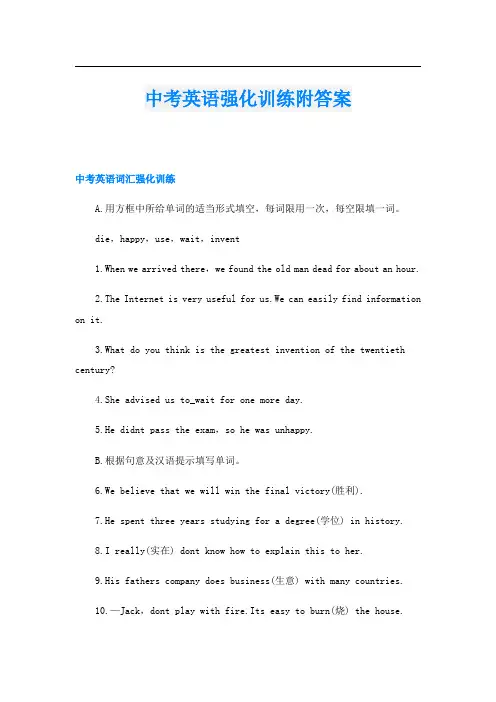
中考英语强化训练附答案中考英语词汇强化训练A.用方框中所给单词的适当形式填空,每词限用一次,每空限填一词。
die,happy,use,wait,invent1.When we arrived there,we found the old man dead for about an hour.2.The Internet is very useful for us.We can easily find information on it.3.What do you think is the greatest invention of the twentieth century?4.She advised us to_wait for one more day.5.He didnt pass the exam,so he was unhappy.B.根据句意及汉语提示填写单词。
6.We believe that we will win the final victory(胜利).7.He spent three years studying for a degree(学位) in history.8.I really(实在) dont know how to explain this to her.9.His fathers company does business(生意) with many countries.10.—Jack,dont play with fire.Its easy to burn(烧) the house.—Sorry.I wont do that again.中考英语语法强化训练Most of us have probably heard of Mickey Mouse,Donald Duck,and many __11__ famous Disney characters.Perhaps we have even seen them in__12__(movie).But have you ever been to Disneyland?In fact,there are now several different Disneyland amusement parks __13__ the world.Disneyland is an amusement park,but we can __14__ call it a theme park.It has all the normal attractions that you can find at an amusement park,but __15__ also has a theme.The theme,of course,is Disney movies and Disney characters.For __16__,you can find a roller coaster in__17__(most) amusement parks,but in Disneyland,the theme of the roller coaster is Disney characters.This __18__ (mean) that you can find Disney characters all over the roller coaster.You can also watch Disney movies,__19__ (eat) in Disney restaurants,__20__ buy Disney gifts.And you can see Disney characters walking around Disneyland all the time!11.other 12.movies 13.around_in 14.also15.it 16.example 17.most 18.means19.eat 20.and中考英语完形强化训练Nowadays __21__ Chinese teenagers find life more difficult __22__ their parents.They dont know how to do __23__.Because their parents do almost __24__ for them at home.This is a big problem.Joy is 14 years old.One day her parents went away __25__ business,so she had to stay at home alone.At first she thought she would be happy__26__ her parents were not in.She could do everything __27__ she liked.But it was six oclock in the afternoon,she felt __28__.“Oh,its time to have __29__.Where can I get my food?” she said to ter she found some food in the fridge,but she __30__ know how to cook.At that moment,she missed her __31__ very much.At last she could only go to the supermarket and __32__ some food to eat.Many of teenagers are __33__ as Joy.So I think they should learn some basic life __34__,like cooking,tidying up their rooms or dressing themselves __35__.They shouldnt depend too much on their parents.( C )21.A.much and moreB.many and moreC.more and moreD.less and less( D )22.A.from B.for C.withD.without( D )23.A.their homework B.some shoppingC.businessD.housework( A )24.A.everything B.nothingC.somethingD.none( C )25.A.in B.at C.on D.with( B )26.A.so B.because C.but D.until( A )27.A.that B.who C.where D.when( A )28.A.hungry B.full C.excited D.bored( C )29.A.breakfast B.lunchC.supperD.a sleep( B )30.A.couldnt B.didntC.might notD.wouldnt( D )31.A.cousin B.aunt C.brother D.parents( B )32.A.made B.bought C.gave D.saw( A )33.A.the same B.difficultC.differentD.warmhearted( D )34.A.styles B.ways C.rules D.skills( C )35.A.actually B.carelesslyC.properlyD.slowly中考英语阅读强化训练Katherine Commale is an 11yearold girl from Pennsylvania.At the age of five she began raising money to buy nets for children in Africa to help stop the spread of malaria(疟疾).When she was five,Katherine learnt about malaria in Africa.She learnt that every 30 seconds a child died from this disease.She also learnt that people wouldnt get that disease if they had enough bed nets.“I was really sad to learn that a child died every half a minute because of malaria.”Says Katherine,“I wanted to send nets right away,so thats what I did.”Fiveyearold Katherine made presentations at churches and schools.She told students and others how important bed nets were for Africans.Afterpeople heard the presentations,many of them donated money.Katherine sent the money to NBN.NBN is an organization that sends bed nets to Africa.Besides,every holiday Katherine makes something called “bed net gift certificate”with the help of her friends and brothers.On each 10dollar certificate there is a message.It explains that a bed net would be sent to Africa.When more certificate orders come,Katherine gets help from students in her school.Katherine has helped to raise $200,000 for NBN.“It makes me proud to help African children.I wont stop working until everyone in Africa hasa bed net.”says Katherine.36.Which of the following is TRUE according to the passage?__B__A.When Katherine was six,she began helping children in Africa.B.Katherine learnt that two children died from malaria one minute.C.Katherine did a lot and helped to raise $ 20,000 for NBN.D.Katherines parents helped her make “bed net gift certificate”.37.In Paragraph 4,“It” refers to “ ________”.__D__A.a 10dollar noteB.a gift certificateC.an organizationD.a message38.From the passage we know Katherine did the following EXCEPT __D__.A.raising a great deal of money for NBNB.giving presentations at churches and schoolsC.explaining the importance of nets for AfricansD.ordering people to learn to use the nets well39.It can be inferred from the passage that __A__.A.Katherines work is very helpful and meaningfulB.the spread of malaria in Africa will be more seriousC.every child in Africa gets a net with Katherines helpD.Katherine has received much money from NBN中考英语作文强化训练学会自我保护是青少年需要具备的一种意识和能力。
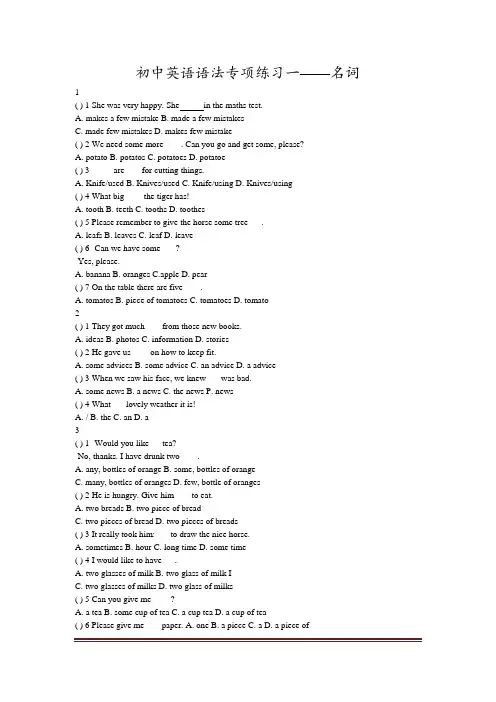
初中英语语法专项练习一——名词1( ) 1 She was very happy. She in the maths test.A. makes a few mistakeB. made a few mistakesC. made few mistakesD. makes few mistake( ) 2 We need some more____. Can you go and get some, please?A. potatoB. potatosC. potatoesD. potatoe( ) 3 _____are____for cutting things.A. Knife/usedB. Knives/usedC. Knife/usingD. Knives/using( ) 4 What big____ the tiger has!A. toothB. teethC. toothsD. toothes( ) 5 Please remember to give the horse some tree___.A. leafsB. leavesC. leafD. leave( ) 6 -Can we have some ___?-Yes, please.A. bananaB. orangesC.appleD. pear( ) 7 On the table there are five____.A. tomatosB. piece of tomatoesC. tomatoesD. tomato2( ) 1 They got much ___ from those new books.A. ideasB. photosC. informationD. stories( ) 2 He gave us____ on how to keep fit.A. some advicesB. some adviceC. an adviceD. a advice( ) 3 When we saw his face, we knew___ was bad.A. some newsB. a newsC. the news P. news( ) 4 What___ lovely weather it is!A. /B. theC. anD. a3( ) 1 -Would you like___tea?-No, thanks. I have drunk two____.A. any, bottles of orangeB. some, bottles of orangeC. many, bottles of orangesD. few, bottle of oranges( ) 2 He is hungry. Give him ___ to eat.A. two breadsB. two piece of breadC. two pieces of breadD. two pieces of breads( ) 3 It really took him:___ to draw the nice horse.A. sometimesB. hourC. long timeD. some time( ) 4 I would like to have___.A. two glasses of milkB. two glass of milk IC. two glasses of milksD. two glass of milks( ) 5 Can you give me ____?A. a teaB. some cup of teaC. a cup teaD. a cup of tea( ) 6 Please give me ___ paper. A. one B. a piece C. a D. a piece of( ) 7 John bought___for himself yesterday.A. two pairs of shoesB. two pair of shoeC. two pair of shoesD. two pairs shoes 4( ) 1 -How many ____ have you got on your farm?-I've got five.A. sheepsB. sheepC. pigD. chicken( ) 2 Some ___ came to our school for a visit that day.A. GermansB. GermenC. GermanyD. Germanies( ) 3 In the picture there are many____ and two.A. sheep; foxes C. sheeps; foxesB. sheeps; fox D. sheep;foxs( ) 4 A group of______ will visit the museum tomorrow.A. HungarianB. AustralianC. JapaneseD. American5( ) 1 This table is made of___.A. many glassB. glassesC. some glassesD. glass( ) 2 -What would you like to have for lunch, sir?-I'd like____. !A. chickenB. a chickenC. chickensD. the chicken( ) 3 Children should make____ for old people in a bus.A. roomB. a roomC. roomsD. the room6( ) 1 Tables are made of___.A. woodB. some woodsC. woodenD. woods( ) 2 I wonder why ______ are so interested in action (武打片) films.A. peopleB. peoplesC. the peopleD. the peoples( ) 3I have read____ of the young writer.A. worksB. workC. this worksD. the works7( ) 1 Let's meet at 7: 30 outside the gate of___?A. the People's ParkB. the Peoples' ParkC. the People ParkD. People's Park( ) 2 ___ Chinese people are ___ hard working people.A. /; aB. We; theC. The; theD. The; a( ) 3 How many were there in the street when the accident happened?A. policemanB. policesC. policeD. peoples8( ) 1 If these trousers are too big, buy a smaller____.A. setB. oneC. pieceD. pair( ) 2 Last week I bought a TV____.A. pair .B. setC. pieceD. block( ) 3 There is a of wood left on the ground.A. cupB. piece ,C. boxD. pair9( ) 1 There are sixty-seven___ in our school.A. women's teacherB. women teachersC. woman teachersD. women teacher ( ) 2 There are five___in our factory.A. woman driver B, women driver C. woman drivers D. women drivers ( ) 3 These ____ were sent to the villages to help the farmers.A. women doctorB. women doctorsC. woman doctorsD. woman doctor10( ) 1 They write most of their___ in English.A. business letterB. business lettersC. businessesD. businesses letters ( ) 2 We came to a ___ at last .and went in.A. watch shopB. watches shop ,'C. watching shopD. watchs shop( ) 3 This shop sells apples, bananas and things like these. It's a___.A. food shopB. book shopC. fruit shopD. vegetable shop( ) 4 She broke a___while she was washing up.A. glass of wineB. glass for wineC. glass wineD. wine glass( ) 5 I've forgotten both of the____.A. room numbers .B. rooms numberC. rooms numbersD. room number111. September 10th is____in China.A. Teacher's DayB. Teachers'DayC. Teacher DayD. Teachers Day( ) 2 -Is the broom under ____ desk? -No, it's under____.A. the teacher's; myB. teacher's; mineC. teacher's; meD. the teacher's; mine ( ) 3 Excuse me, where is the___?A. men's roomB. mens' roomC. men's roomsD. men rooms12( ) 1 The football under the bed is____.A. Lily and LucyB. Lily's and Lucy'sC. Lily's and LucyD. Lily and Lucy's ( ) 2 This is my____dictionary.A. sister MaryB. sister'sC. sister, Mary'sD. sister's Mary's( ) 3 He went to ___ shop to buy a shirt.A. a tailorB. the tailorC. a tailorsD. the tailors'( ) 4 Joan is____.A. Mary's and Jack sisterB. Mary and Jack's sisterC. Mary and Jack sisterD. Mary's and Jack's sister13( ) 1 In a few____ time, those mountains will be covered with trees.A. yearB. years'C. year'sD. years( ) 2 It's about ___ walk from my house.A. ten minuteB. ten minutes'C. ten minute'sD. ten minutes( ) 3 The post office is a bit far from here. It's about_____.A. thirty minutes's walkB. thirty minute's walkC. thirty minutes' walkD. thirty minutes walk( ) 4 Half___ telephone calls are made in English.A. the worldB. worldC. the world'sD. world's14( ) 1 ____ face to the south.A. Windows of the roomB. The windows of the roomC. The room's windowsD. The windows in room( ) 2 Please take two___.A. picture of the parkB. pictures of the parkC. the pictures of a parkD. picture of a park( ) 3 The workers are repairing____.A. the roof of the houseB. a roof of the houseC. roof of the houseD. this roof of house15( ) 1 Miss Smith is a friend of____.A. Mary's mother'sB. Mary's motherC. mother's of MaryD. Mary mothers ( ) 2 This is a book of ___.A. TomB. Tom'sC. herD. him( ) 3 The post card is sent by ____.A. a friend of my fatherB. a friend of my father'sC. my father friendD. my father friend's16( ) 1 Sydney is a city of___.A. AmericaB. GermanyC. AustraliaD. Japan( ) 2 My father likes buying us ___.A. carsB. flowersC. peasantsD. presents( ) 3 In England, the last name is the ___.A. full nameB. family nameC. middle nameD. given name( ) 4 Mr Gao is a teacher. He works in a new____.A. shopB. schoolC. factoryD. hospital17( ) 1 My father is a____. He works in a hospital.A. teacherB. doctorC. farmerD. soldier( ) 2 -Which animal lives only in China?-The____.A. tigerB. monkeyC. pandaD. elephant( ) 3 April come before___and after___.A. March; MayB. May; MarchC. June; MayD. March; February( ) 4 Which of the following is right?A. China has a large population.B. China has much population.C. China has many populations.D. China has a great deal of population. ( ) 5 Please do like this. Fold the paper____ and cut along the fold.A. into piecesB. in halfC. on halvesD. to half( ) 6 You played the violin wonderfully. Will you please play another____?A. oneB. gameC. programmeD. piece初中英语语法专项练习二——形容词一选择正确的答案1.Which does Jimmy like _______, Chinese or art?A. wellB. bestC. betterD. much2. The Changjiang River is one of ______ in the world.A. the longest riverB. The moreC. the longest riversD. longer river3. ______ of the two women is Mrs Brown.A. The beautifulB. The more beautifulC. More beautifulD. The most beautiful4. My mooncake is nicer _______ his.A. likeB. withC. forD. than5. You are fatter than _______.A. heB. hisC. himD. he is tall6. He jumps _______ of the three.A. farB. futherC. farthestD. furthest7. My hair is longer than _______.A. my sisterB. KateC. my brother’sD.Lucys’8. There is ______ paper here. Please bring some.A. littleB. lessC. fewerD. a little9. The pen is ______ than that one.A. more cheapB. cheapC. much cheaperD. quite cheaper10. Tom speaks Chinese _______ better than Jimmy.A. moreB. veryC. a lotD. much11. There are _______ girls in Class 2 than in Class 4.A. moreB. nicestC. mostD. best12. It’s too ______ for you to do that.A. easyB. more dangerousC. harderD. the easist13. Who has ______ apples now, Jim, Lily or Lucy?A. muchB. biggestC. betterD. the most14. You have more rulers than me. But ______ are nicer than _______.A. mine, yoursB. mine, yourC. my, yoursD. my, your15. Tingting is ______ than Meimei,but Meimei is ______ than Tingting.A. tall, strongerB. taller, strongestC. tallest, strongD. taller, stronger16. Mother is _______ in my family.A. busyB. busierC. the busiestD. more busy17. There are _______ in the park on Sundays.A. more childrenB. a lot of peopleC. much men and womenD. many peoples18. The dumplings are _______ than the noodles, I think.A. more nicerB. much deliciousC. very niceD. much more delicious19. She is _______ than me at drawing.A. betterB. bestC. goodD. harder20. This blue sweater is too big for me. Will you please show me a ______ one?A. smallB. smallerC. the smallestD. smallest二.用所给词的适当形式填空1. Your classroom is _______ (wide) and _______ (bright) than ours.2. There are _______ hours of sunlight a day in winter than in summer. (few)3. Which do you like _______, maths or chemistry?(well)4. This is the ______ film I have ever seen. (good)5. Africa is the second _______ continent. (large)6. What he said made his mother much ______. (angry)7. I’m not as _______ as he. (careful)8. We’ve got as _______ books as we need.(many)9. They have done _______ (much) work with ______ (little) money.10. Practice as ______ as you can. (much)11. You’re the ______ person I’ve ever seen. (kind)12. He is _____ than his two sisters. (young)13. The ______ (old) I get, the ______ (strong) I seem to feel.14. The weather is getting ______ (warm) and ______ (warm).15. You are far ______ than you were. (polite)16. The patient is no ______ than people. (well)17. Summer is ______ season of the year. (hot)18. I can do it well with even ______ money. (little)三.中考真题测试1. The air in Beijing is getting much ______ now than a few years ago. (2005年北京)A. cleanB. cleanerC. cleanestD. the cleanest2. My cousin has changed a lot. She used to be ______ but now she is tall.A. shortB. thinC. prettyD.heavy3. Mobile phones are very popular now and they are ______ than before. (2005北京海淀)A. cheapB. cheaperC. cheapestD. the cheapest4. —We spent all our money because we stayed at the most expensive hotel in town. —Why didn’t you stay at _____ one?A. a cheapB. a cheaperC. the cheapD. the cheaper5. —Do you like western food?— No. The food of our country is ______ that of western countries. (2005年广州)A. rather good thanB. much better thanC. more better thanD. not so good as6. This is _____ that all of us believe it’s very important. (2005年广州)A. such useful informationB. so useful an informationC. so useful informationD. such a useful information7. — Mum, could I have an MP3— Certainly, we can buy _____ one, but as good as this. (2005年沈阳)A. a cheapB. a cheapestC. a cheaperD. the cheapest8. The harder we work, the ______ result we will get.(2005年大连)A. fasterB. fewerC. betterD. the cheapest9. We should keep our eyes ______ while doing eye exercises. (2005年吉林)A. closeB. closedC. openD. opened10. Look at the man in the right picture. He is ______. (2005年吉林)A. right-handedB. left-handedC. no handD. a hand11. — Tom is good at drawing. How about Mike?— Mike is ______, I think. He has got more prizes than Tom.(2005年河南)A. wellB. OKC. goodD. better12. — Have you bought that digital camera?—No, I can’t afford it. The price is a bit ______. (2005年河南)A. nowB. highC. cheap expensive13. Now more and more Chinese people are ______ enough to buy cars.A. richB. weakC. poorD. strong14. Kate is rea lly ______. She’s never angry with others. (2005年安徽)A. tallB. friendlyC. luckyD. clever15. —Which is ______ river in China? (2005年武汉)— The Changjiang River.A. longerB. the longestC. longestD. the longer参考答案;一.1. C 2. C 3. A 4. D 5. C6. C 三个人或三人以上比较时,用形容词最高级,表示“最远”用farthest, 而further, furthest 多表示抽象意思,“更进一步”等7. C8. A little, a little修饰不可数名词,little表示否定含义,意为“没多少” a little表示肯定含义,意为“有一点儿”9. C 10. D11-15AADAD 16-20 CBDAB二.1. wider, brighter 2. fewer 3. better 4. best 5. largest 6. angrier 7. careful 8. many9. more, less 10. much 11. kindest 12. younger 13. older, stronger 14. warmer,warmer 15. politer 16. better 17. the hottest 18. less三.1-5 BABBB 6-10 ACCBB 11-15 DBABB初中英语语法专项练习三——代词单项填空: 人称代词、物主代词、反身代词、指示代词和疑问代词1. ____ is she? She's a nurse.A. WhoB. WhereC. WhichD. What2. ____ is Tom like? Oh, he's short.A. WhichB. WhoC. WhatD. Whom3. ____ cap is that?A. Who'sB. WhoC. WhoseD. Where4. ____ is no use telling him about that.A. ThisB. ThatC. TheseD. It5. The three men, Bob, Joe and ____ met at the station.A. IB. meC. herD. you6. ____ have been to Paris.A. I, you and heB. He, you and IC. You, he and ID. You, he and me7. My brother is so young that he can't take care of ____ .A. himB. herselfC. himselfD. his8. The young teacher teaches ____ politics.A. usB. ourC. oursD. ourself9. Our work is not so good as ____ .A. himB. heC. hisD. he's10. Has Jack got the money? Yes, I gave ____ yesterday.A .to him them B. to him if C. him them D. it to him11. How hard ____ works!A. we B .him C. he D. his12. Won't you let ____ help you?A. I and my friendB. my friend and IC. my friend and meD. my friend and I to13. He asked the three men, Bob, Joe and ____ to be ready.A. IB. himselfC. meD. herself14. All my classmates are going to the Summer Palace except ____ .A. he and IB. he and meC. him and ID. him and me15. Go ____ to ____!A. here, usB. there, theyC. there, themD. here, we16. The moon is shining brightly tonight .____ is like a round plate.A. ItsB. HeC. SheD. They17. He is as tall as ____ .A. sheB. herC. himD. himself18. If I were ____ , I would take the advice.A. sheB. herC. heD. his19. Open the door. please? It's ____ .A. IB. myC. mineD. me20. She hasn't brought ____ book with her. Will you lend her ____?A. hers, yourB. her, yourC. hers, yoursD. her, yours21. That's not ____ ; it is ____. I made it ____.A. yours, mine, myselfB.your, mine, myselfC. yours, her, myselfD. yours, my, myself22. John's book is more interesting than ____ .A. your bookB. your oneC. yourselfD. yours23. Either Mary or her parents will let me use ____ car.A. herB. theirC. mineD. him24. The bird builds ____ nest in the tree.A. herB. it'sC. itsD. her's25. The sun makes ____ day and night.A. itsB. weC. ourD. ours.26. ─I've forgotten my bread.─Never mind, you can have ____ .A. some of usB. us someC. some of oursD. some of our27. Two sisters of ____ help us with our English.A. himB. hisC. heD. he's28. Are they friends ____ ?A.of youB.to youC. to yoursD.of yours29. Lily and Bill want to see it ____ .A. theirselvesB. themselvesC. himselfD. themself30. We had better ask the secretary ____ .A. hisB. himC. himselfD. themselves31. We met his grandma ____ .A. himselfB. hersC. herselfD. her32. The girl dresses ____ when she gets up.A. herB. sheC. herselfD. himself33. Please help ____ to some tea.A. meB. himC. yourselfD. yours34. Tom is not quite ____ today.A. hisselfB. himC. hisD. himself35. I'll bring ____ dictionary with me.A. myselfB. ourselvesC. my ownD. own36. ____ magazine is over there.A. TheseB. ThoseC. ThisD. That37. ____ a good idea.A. This isB. That's38. He was ill. ____ is why he didn't attend the meeting.A. ThisB. ItC. ThereD. That39. What I want to tell you is ____ : The meeting is put off till Friday.A. itB. thisC. thatD. its40. She went to swim and I'll do ____ .A. suchB. sameC. the same asD. the same41. Our feeling was ____ .A. the same as theyB. same as theirsC. same as theyD. the same as theirs42. They left for Shanghai on ____ day.A. the sameB. such43. You can do it now or leave it till later, it is ____ to me.A. the sameB. all the same44. Who is that boy ? ____ .A. He is a studentB. He is a workerC. He is my brotherD. He is tall45. It was ____ warm day that they went swimming.A. suchB. such aC. soD. so a46. It was ____ a long time ago.A. suchB. very47. ____ is he? He is a bus driver.A. WhoB. WhichC. ThatD. What48. How is your brother ? ____ .A. That's heB. That's himC. He's very goodD. He's very well49. ____ these girls do you know?A. Which ofB. Who areC. WhatD. How many50. ____ paper do you read? I read " China Daily ".A. WhichB. HowC. How manyD. What51. ____ is the quickest way from here to the Bank?A. WhatB. WhichC. What wayD. Which the way52. What' s his name ? ____.A. It JohnB. John it's the nameC. It's JohnD. Its John53. What colour are your new shoes ? ____ .A. They are brown colourB. It's brownC. They are brownD. They are colour brown54. ____ hat is that?A. Who'sB. WhoseC. WhoD. Whom55. The TV sets made in Shanghai are much better than ____ made in Beijing.A. thatB. theseC. thoseD. it单项填空: 不定代词(70分, 70分钟)1. If you need money, I'll lend you ____ .A. oneB. someC. anyD. those2. The pen I'm writing with is different from ____ .A. that onesB. that oneC. that one'sD. those one3. I remember ____ word he said that day.A. allB. noneC. bothD. every4. " Does he study physics or chemistry ?" " He studies ____ ."A. eitherB. neitherC. none D .all5. "Does he study English or Russian ?" "He studies ____ ."A. bothB. allC. eitherD. none6. There are several windows in the room. The ____ face south.A. bothB. allC. everyD. either7. Do you have ____ to say at the meeting?A. something importantB. anything importantC. important somethingD. important anything8. I've had enough bread, would you like ____ ?A. one moreB. some moreC. any muchD. another more9. ____ wore what she liked best.A. Each of the womenB. Each of the womanC. Each of womenD. Each the women10. I don't know ____ .A. anyone of themB. any one of childrenC. no oneD. any one of the children11. She has four daughters. One is a doctor, but ____ are workers.A. anotherB. otherC. the othersD. the other12. I asked her if she know ____ .A. all themB. them allC. them of allD. every them13. ____ can always try to do a little better than ____ best.A. One, youB. One, oneC. One, hisD. One, one's14. One of the students hasn't prepared ____ lessons very well.A. one'sB. onesC. theirD. his15. Everyone should be careful of ____ pronunciation.A. theirB. onesC. ourD. his16. Have you any books on cooking? I'd like to borrow ____ .A. itB. thatC. thisD. one17. Have you got any apples? Yes, I've got ____ .A. a smallB. some smallC. two small onesD. two small18. Is this your coat? No, mine is ____.A. one blueB. a blue one19. If you need money,I'll lend you ____ .A. oneB. itC. thoseD. some.20. "Have you found the pen you lost yesterday ?"A. oneB. the oneC. one'sD. it21. I've got ____ interesting books.A. someB. any22. Put ____ bread on the table; we need ____ more.A. any, someB. some, anyC. some, someD. any, any23. There isn't ____ work for us to do.A. someB. any24. He remembers having read about it in ____ .A. any storybookB. some storybook25. I have ____ important to tell you.A. somethingB. anything26. Is there ____ wrong with your TV set?A. somethingB. anything27. If there are ____ good apples in the shop, buy me two pounds.A. someB. any28. Both of these are interesting books. You can borrow ____ of them.A. anyB. either29. All these are interesting books. You can borrow ____ of them.A. anyB. both30. Come ____ you like.A. some dayB. any day.31. ____ can answer the question. It's quite easy.A. SomebodyB. Anybody32. Why don't you get ____ to read during the winter vacation (寒假) ?A. anythingB. something33. Would you like ____ beer?A. anyB. some34. ____ of the students was given a book.A. EachB. Every35. ____ student should respect (尊敬) the teacher.A. EachB. Every36. Two boys came and I gave an apple to ____ .A. eachB. every37. The soldiers lined on ____ side of the road.A. eachB. every38. Everyone must do ____ best to help others.A. one'sB. his39. Here are two dictionaries. You may use ____ of them.A. eitherB. eachC. everyD. all40. There are flowers on ____ side of the door.A. eitherB. both41. On ____ banks of the river there are trees and flowers.A. eitherB. both42. He lent me two books, but ____ of them is easy to read.A. bothB. neither43. He lent me a few books, but ____ of them are easy to read.A. neitherB. none44. His parents are ____ English teachers.A. allB. both45. ____ like music.A. the both girlsB. Both this girlsC. Both of themD. Both they46. ____ are very good.A. Both theyB. The both boysC. Both those boysD. Both of they47. There are two windows in the room. They ____ face south.A. allB. bothC. everyD. either48. Does he speak English or Russian? He doesn't speak ____ .A. eitherB. neitherC. noneD. all49. The teacher wanted to invite them ____ to the musical evening.A. everybodyB. all50. I've read ____ of the books.A. no oneB. none51. " How many elephants did you see ?" "____."A. NoneB. No oneC. Not many onesD. No many52. My sister gave me two pictures.One is the Great Wall, ____ isthe Ming Tombs (明十三陵) .A. anotherB. the other53. Some like physics, ____ like chemistry.A. the othersB. others54. He has four brothers. One is in Beijing, but ____ are in Nanjing.A. anotherB. otherC. the otherD. the others55. I have five colour pencils. One is red, another is blue and ____ green.A. otherB. the otherC. othersD. the others56. I don't think this is a good idea. Has he any ____ suggestion (建议) ?A. oneB. anotherC. otherD. the other57. These cups are ours. Those are ____ .A. othersB. others'C. other'sD. others's58. The coat is too big. Please show me ____ .A. otherB. another59. Have ____ , please!A. the other cup of teaB. another cup of tea60. They are talking ____.A. each otherB. one anotherC. one to anotherD. to each other61. Joan dances better than ____ in the school.A. any girlB. any other girlC. some girlD. some other girl62. We have only ____ tickets left.A. fewB. a fewC. littleD. a little63. Not all workers go home on Saturday; ____ still stay in the factory.A. a fewB. fewC. noneD. a little64. A lot of people have tried, but ____ have succeeded (成功).A. the fewB. fewC. someD. a few65. He says ____ but does much.A. fewB. a littleC. littleD. a few66. Hurry up! We have only ____ time left.A. fewB. a fewC. littleD. a little67. Fred eats ____ bread.A .too many B. so much C. fewer D. so many68. How ____ is that fish?A. manyB. muchC. moreD. most69. Try to make as ____ mistakes as possible in your homework.A. lessB. littleC. fewD. fewer70. Quite ____ people came to the party though it was raining hard.A. fewB. a fewC. littleD. a little1.D2. C3. C4. D5. A6. C7. C8. A9. C 10. D11. C 12. C 13. C 14. D 15. C 16. C 17. A 18. B 19. D 20. D21. A 22. D 23. B 24. C 25. C 26. C 27. B 28. D 29. B 30.C31. C 32. C 33. C 34. D 35. C 36. D 37. B 38. D 39. B 40.D41. D 42. A 43. B 44. C 45. B 46. A 47. D 48. D 49. A 50.D51. B 52. C 53. C 54. B 55. C1. 1-7 C C B B B B C2. 1-4 C B C A3. 1-7 B C D A D D A4. 1-4 B A A C5. 1-3 D A A6. 1-3 A A D7. 1-3 A D C8. 1-3 D B B9. 1-3 B D B10. 1-5 B A C D A11. 1-3 B D A12. 1-4 D C C B13. 1-4 B B C C14. 1-3 B B A15. 1-3 A B B16. 1-4 C D B B17. 1-6 B C B A B D初中英语语法专项练习四——数词1. 1). There are ___ days in a year.A. three hundreds sixty-fiveB. three hundreds and sixty-fiveC. three hundred and sixty-fiveD. three hundred and sixty five2). There are____ students in this school.A. eight hundreds and forty-sixB. eight hundred and forty sixC. eight hundred and forty-sixD. eight hundred forty-six2. 1).______people visit this museum every day.A. HundredB. HundredsC. Hundred ofD. Hundreds of2).There are two___ people in the meeting room.A. hundredB. hundredsC. hundreds ofD. hundred of3). Every year ___ watch NBA on TV.A. million peopleB. millions of peopleC. millions peopleD. million of people4). ____ trees have been planted in our school in the past 10 years.A. Thousands ofB. Two thousandsC. Thousand ofD. Two thousand of5). Look! There are ___ in the sky.A. thousand starsB. thousand of starsC. thousands of starsD. thousands of star3. 1). My brother is in____.。
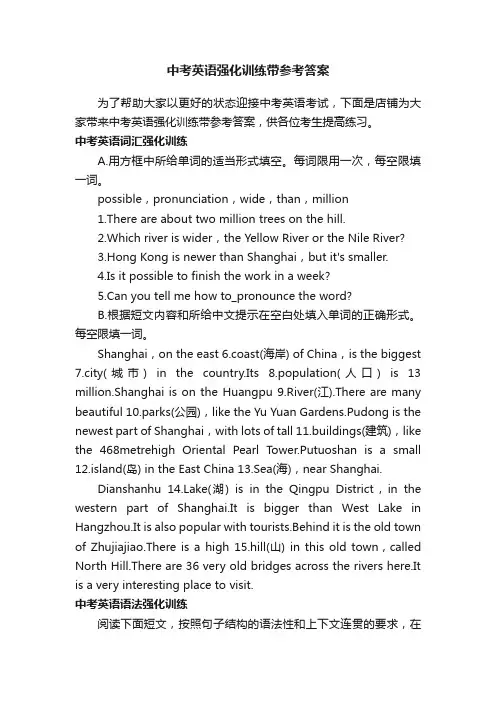
中考英语强化训练带参考答案为了帮助大家以更好的状态迎接中考英语考试,下面是店铺为大家带来中考英语强化训练带参考答案,供各位考生提高练习。
中考英语词汇强化训练A.用方框中所给单词的适当形式填空。
每词限用一次,每空限填一词。
possible,pronunciation,wide,than,million1.There are about two million trees on the hill.2.Which river is wider,the Yellow River or the Nile River?3.Hong Kong is newer than Shanghai,but it's smaller.4.Is it possible to finish the work in a week?5.Can you tell me how to_pronounce the word?B.根据短文内容和所给中文提示在空白处填入单词的正确形式。
每空限填一词。
Shanghai,on the east 6.coast(海岸) of China,is the biggest 7.city(城市) in the country.Its 8.population(人口) is 13 million.Shanghai is on the Huangpu 9.River(江).There are many beautiful 10.parks(公园),like the Yu Yuan Gardens.Pudong is the newest part of Shanghai,with lots of tall 11.buildings(建筑),like the 468metrehigh Oriental Pearl T ower.Putuoshan is a small 12.island(岛) in the East China 13.Sea(海),near Shanghai.Dianshanhu ke(湖) is in the Qingpu District,in the western part of Shanghai.It is bigger than West Lake in Hangzhou.It is also popular with tourists.Behind it is the old town of Zhujiajiao.There is a high 15.hill(山) in this old town,called North Hill.There are 36 very old bridges across the rivers here.It is a very interesting place to visit.中考英语语法强化训练阅读下面短文,按照句子结构的语法性和上下文连贯的要求,在空格处填入一个适当的词或使用括号中词语的正确形式填空。
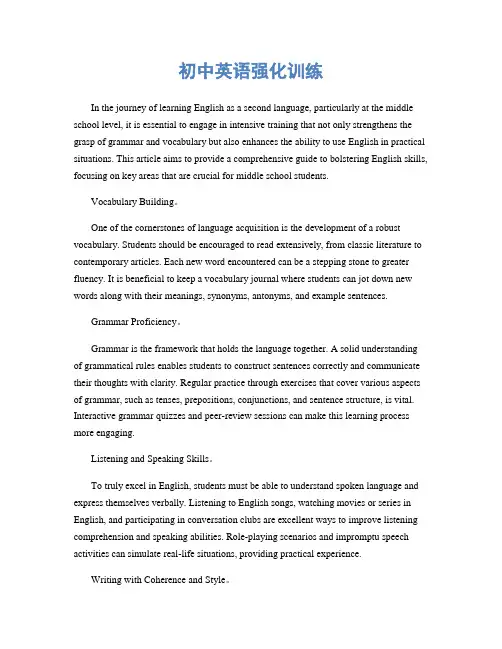
初中英语强化训练In the journey of learning English as a second language, particularly at the middle school level, it is essential to engage in intensive training that not only strengthens the grasp of grammar and vocabulary but also enhances the ability to use English in practical situations. This article aims to provide a comprehensive guide to bolstering English skills, focusing on key areas that are crucial for middle school students.Vocabulary Building。
One of the cornerstones of language acquisition is the development of a robust vocabulary. Students should be encouraged to read extensively, from classic literature to contemporary articles. Each new word encountered can be a stepping stone to greater fluency. It is beneficial to keep a vocabulary journal where students can jot down new words along with their meanings, synonyms, antonyms, and example sentences.Grammar Proficiency。
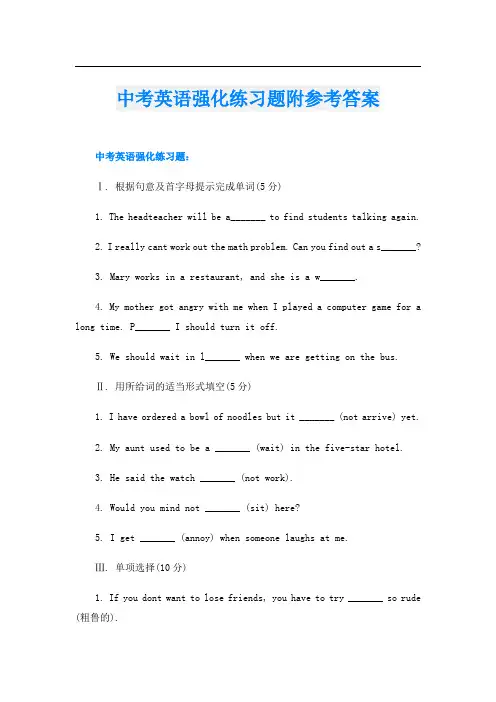
中考英语强化练习题附参考答案中考英语强化练习题:Ⅰ. 根据句意及首字母提示完成单词(5分)1. The headteacher will be a_______ to find students talking again.2. I really cant work out the math problem. Can you find out a s_______?3. Mary works in a restaurant, and she is a w_______.4. My mother got angry with me when I played a computer game for a long time. P_______ I should turn it off.5. We should wait in l_______ when we are getting on the bus.Ⅱ. 用所给词的适当形式填空(5分)1. I have ordered a bowl of noodles but it _______ (not arrive) yet.2. My aunt used to be a _______ (wait) in the five-star hotel.3. He said the watch _______ (not work).4. Would you mind not _______ (sit) here?5. I get _______ (annoy) when someone laughs at me.Ⅲ. 单项选择(10分)1. If you dont want to lose friends, you have to try _______ so rude (粗鲁的).A. to not beB. not to beC. to be notD. dont be2. It may take a long time to find a _______ the problem.A. answer ofB. key ofC. solution toD. way to3. She got _______ at his question and left the room angrily.A. happyB. annoyedC. interestedD. annoying4. —Do you think its going to rain?—_______. Ican see some blue sky.A. I think soB. Perhaps notC. I think notD. Perhaps so5. Jim lives next _______ me, so we often play chess together.A. door toB. door fromC. room ofD. house fromⅣ. 完成句子(10分)1. 我们应该尽量做到不烦恼。
初三英语语法强化练习题及答案1. 选择题1. — _______ do you usually go to school?— By bike.A. HowB. WhatC. WhenD. Why2. Lisa _____ swimming every Sunday morning.A. goB. goesC. is goingD. went3. Don't worry. I _______ a mistake next time.A. not makeB. will not makeC. don't makeD. didn't make4. Tom _____ football yesterday afternoon.A. playedB. playC. is playingD. plays5. — Did you see Mary at the party?— No, by the time I got there, she _______.A. leavesB. had leftC. has leftD. will leave答案:1. A2. B3. B4. A5. B2. 完成句子1. I often ____ (help) my mother with the cooking on weekends.2. They _______ (not watch) TV last night. They went to the cinema instead.3. Sam ______ (buy) a new bike for his birthday next month.4. The teacher told us ______ (not make) noise in class.5. My sister and I _______ (visit) our grandparents every summer vacation.答案:1. help2. didn't watch3. will buy4. not to make5. visit3. 改错题1. He am going to play basketball after school.2. How many fishes did you caught at the lake?3. We was studying when the lights went out.4. Sarah and Jane is best friends.5. My brother go to the park every Sunday.答案:1. am → is2. caught → catch3. was → were4. is → are5. go → goes4. 完形填空AMany people love to travel, but not everyone enjoys the same way to travel. Some people enjoy traveling by plane because it is fast and __1__. They can get to their destination (目的地) in a short time. Some people enjoy traveling by train because they can see the __2__ along the way. They can meet __3__ people and talk to them.BOthers love to travel by car. They can enjoy the __4__ view (风景) and stop whenever they like. They can take _____5____ photos. Some people love to travel on foot or by bike. They can stop and look at the view __6__. If they are tired, they can __7__ and take a rest. They can ____8___ anything they like on the way.CDifferent ways of traveling have different ___9___. All in all, __10__ allows us to learn more about the world and enjoy the beauty of life.1. A. comfortable2. A. sun3. A. much4. A. bad5. A. more6. A. faraway7. A. work8. A. look9. A. purposes10. A. travel答案:1. fast2. view3. more4. beautiful5. more6. closely7. sit8. buy9. advantages10. Travel以上是初三英语语法强化练习题及答案,希望对你有所帮助。
七年级英语强化训练4命题人:朱永斌一,根据句子意思和首字母填写单词●I would like an egg and some ________(鸡肉)●May I take your o______?●We often have _________(蔬菜) for lunch.●Wait a __________, please.●Please give me a g ________ of apple juice.二,英汉互译一些水_________________ a bowl of rice__________________Help yourself to some fish _________________________________四川食物_________________ My teacher is friendly to us___________________一,单项选择1,There is some _______ in the bowl.A, meat B, oranges C, apples D, meet2, ----I would like a glass of orange juice. ----___________________A, Can I help you? B, Ok ,thank you C, Here you are3, Let’s _______ some bread.A, to have B, to eat C, have D, drink4, I’m thirsty(渴),Please give me __________.A, some bread B, some rice C,some water, D, a milk5, Would you like to have dinner with me? ----____________A, Ok , here you are B, sorry, I don’t know C, Yes , I’d love to6, My friends are ________ to me.A, friend B, kind C, good D, bad7, Give _____ a cup of tea, please.A, I B, me C, they D, she8,Why not _____ some bread for breakfast?A, have B, having C, has D, had9,How do you like the tea?A, much B, very C, a lot D, at all10,What would you like _____ lunch?A, to B, of C, for D, in四,完型填空Han Mei 1 a Chinese girl. 2 this picture of her family 3 home. 4 can see her father, her mother, her brother 5 her. Han Mei has a 6 . It’s a nice cat. Its 7 is Mimi. Can you see 8 cat? Oh, _9 in Han Mei’s arms. Han Mei has a happy family. She loves her family 10 .( )⒈ A. be B. am C. is D. are( )⒉ A. Look B. Look at C. see D. Read( )⒊ A. at B. on C. of D. in( )⒋ A. We B. They C. She D. He( )⒌ A. but B. and C. or D. too( )⒍ A. dog B. bird C. bike D. pet( )⒎ A. age B. home C. name D. friend( )⒏ A. / B. the C. an D. a( )⒐ A. it’s B. he’s C. she’s D. they’re( )⒑ A. very B. much C. much very D. very much Ⅲ.阅读理解(20分)阅读理解下面的短文,然后按要求答题。
七年级英语强化训练三班级:学号:姓名:Unit 9 My favorite subject is science.一、核心词汇favorite,subject,science,P.E.,music,math,finish,Chinese,geography,history,why,because,free,lesson,Monday,Tuesday,Wednesday,Thursday,Friday,Saturday,Sunday,useful,hour二、重点短语favorite subject最喜欢的科目;the next day第二天;play games with sb.和某人玩游戏;be free有空的;be busy with sth. 忙于某事;be busy doing sth.忙于做某事;after that在那之后;have an art lesson上美术课;for two hours两个小时;have history上历史课三、巩固练习。
(一)短文填空。
I have a good friend. His name is Bruce. We are in Class 6 Grade 7 at Xinhua Middle School. Bruce’s favorite 1 is music. He thinks listening to music①is relaxing. He can 2 well②,too. His favorite singer is Li Jian. His favorite 3 is Tuesday. Why does he like it?4 he has music on Tuesday. He learns many beautiful songs in the music class.5 Monday to Friday③,Bruce goes to school. He is very6 so he has no time to make his room tidy. On weekends,Bruce has no7 but he is busy,too. He has much homework to do. Math is difficult for him. Bruce spends(花费)lots of time on his math homework. His father helps him8 math sometimes. Bruce wants to be9 at all the subjects. But he really needs some 10 time to do his favorite sports,too.1.__________2.____________3.__________4.____________5.__________6.____________7.__________ 8.____________9.__________ 10.____________难点释疑①listen to music听音乐。
七年级英语专项强化训练Units1-3七年级英语专项巩固训练1一.将下列句子变为一般疑问句,并做出肯定与否定回答。
1.This is her eraser._____ _____ her eraser?Yes,______ _____./No,_____ _______.2.That is his pencil box.____ _____ his pencil box?Yes, ___ ____./No, it _______.3.Li Lei is my good friend.____ Li Lei ______ good friend?Yes, _____ _____./No, ______ ________.4.These are nice pictures.______ ______ nice pictures?Yes, ______ ______./No,_____ _______.5.Those are my erasers._____ ______ _______erasers?Yes, ______ ______./No,_____ _______.6.I’m Alice Green.____ _____ Alice Green?Yes, _____ _____./No, ______ _______.7.My name is Tina.____ ______ name Tina?Yes, _____ _____./No, ______ _______.8.The girl’s name is Laura._____ the girl’s name Laura?Yes,_____ ______./No, _____ ______.9.The key is yellow._____ the key yellow?Yes, ____ _____./No, ____ _______.10.H is phone number is 232-4672._____ ______ phone number 232-4672?Yes, ____ _____./No, _____ _______.11.J ohn is my father.____ John ______ father?Yes, ______ _____./No, ____ ______.12.M y friend is Alan.____ ______ friend Alan?Yes, ______ ______./No, _____ _______.二、将下列句子变为否定句1.The key is yellow.The key ___ ____ yellow./The key ______ yellow. 2.M y name’s Gina.My name ____ _____ Gina./My name _____ Gina.3.I’m Dale.I’m _____ Dale./I ___ _____Dale.4.It’s an orange.It ____ _____ an orange./It ______ an orange.5.These are my brothers.These __ __ my brothers./These ____ my brothers.6.Sit down , please!Please ______ ______ down.7.Open your books, please!Please _____ open your books!8.He is Jack.He _____ Jack./He ____ _____ Jack.9.My family are fine.My family _____ ____fine./My family _____fine. 三、对划线部分提问1.It’s a map. _____this in English?2.The key is yellow._____ _____ is the key?3.My name is Dale. _____ _____ name?4.Her name is Jane. ____ _____ name?5.His name is Aric. ____ his name?6.My telephone number is 230-6895._____ ______ telephone number?7.Her last name is Green.____ _____ _____ name?8.He is my English teacher. ____ ____he?/____ he?9.I’m fine.____ _____you?10.They’re my grandparents._____ ___they?/___ they?11.His last name is Miller. ____ his ____name?12.This is an eraser. ______ _______?四、用所给词的适当形式填空。
强化训练复习第一部分TEXT TWOBerkeley seems like a fitting place to find the godfather of the open-innovation movement basking in glory. The Californian village was, after all, at the very heart of the anti-establishment movement of the 1960s and has spawned plenty of radical thinkers. One of them, Henry Chesbrough, a business professor at the University of California at Berkeley, observes with a smile that “this is the 40th anniversary of the Summer of Love.”Mr Chesbrough's two books “Open Innovation” and “Open Business Models” have popularised the notion of looking for bright ideas outside of an organisation. As the concept of open innovation has become ever more fashionable, the corporate R&D lab has become decreasingly relevant. Most ideas don't come from there.To see why travel to Cincinnati, Ohio—which is about as far removed culturally from Berkeley as one can get in America. The conservative mid-western city is home to P&G, historically one of the most traditional firms in America. For decades, the company that brought the world Ivory soap, Crest toothpaste and Ariel detergent had a closed innovation process, centred around its own secretive R&D operations.No longer. P&G has radically altered the way it comes up with new ideas and products. It now welcomes and works with universities, suppliers and outside inventors. It also offers them a share in the rewards. In less than a decade, P&G has increased the proportion of new-product ideas originating from outside of the firm from less than a fifth to around half. That has boosted innovation and, says its boss, Mr Lafley, is the main reason why P&G has been able to grow at 6% a year between 2001 and 2006, tripling annual profits to $8.6 billion. The company now has a market capitalisation of over $200 billion.IBM is another iconic firm that has jumped on the open-innovation bandwagon. The once-secretive company has done a sharp U-turn and embraced Linux, an open-source software language. IBM now gushes about being part of the “open-innovation community”, yielding hundreds of software patents to the “creative commons” rather than registering them for itself. However, it also continues to take out patents at a record pace in other areas, such as advanced materials, and in the process racks up some $1 billion a year in licensing fees.Since an army of programmers around the world work on developing Linux essentially at no cost, IBM now has an extremely cheap and robust operating system. It makes money by providing its clients with services that support the use of Linux—and charging them for it. Using open-source software saves IBM a whopping $400m a year, according to Paul Horn, until recently the firm's head of research. The company is so committed to openness that it now carries out occasional “online jam sessions” d uring which tens of thousands of its employees exchange ideas in a mass form of brainstorming.Mr Chesbrough, of course, heartily approves. He gives dozens of other examples of firms doing similar things, ranging from Clorax, a household products firm to Air Products, an industrial gases company. Mr Chesbrough reckons that “IBM and P&G have timed their shift to a high-volume open-business model very well” and that if their competitors do not do the same they will be in trouble.1. “Summer of Love” is proba bly _____{A} a religious activity celebrating the open-innovation movement.{B} the anti-establishment movement.{C} a movement advocating the innovation.{D} an activity calling for open innovation.2. According to the passage, the annual profits of P&G in 2001 was about_____{A} $ 2.87 billion.{B} $ 1.075 billion.{C} $ 2.15 billion.{D} $ 4.3 billion.3. IBM now gushes about being part of the “open-innovation community” in that_____{A} it embraced an open-source software language that is widely sup ported by the “creative commons”.{B} it endows people inside and outside the company with the access to the software patents it owns.{C} it encourages an extensive public involvement in the development of new software for the company.{D} it indeed whops its cost and gains considerable profit from using Linux.4. IBM could provide its clients with cheap operating system because_____{A} its progrmmers around the world develop Linux essentially at no cost.{B} it makes money by providing its client with toll services supporting the operating system instead.{C} it could save a lot of money by using open-source software.{D} it has shifted its R&D outside, which save a lot of money.5. According to the last paragrph, if their competitors do not do the same they will be in trouble because_____{A} their competitors will would lose their market share gradually which would be taken by R&D.{B} they fail to adopt the new model of open business which would pave the way to constant business success.{C} they do not recognize the best time to shift their backward business model.{D} they will be sifted out by the market as a result of their conservativeness.篇章剖析:这篇文章介绍了开放式发明的一些情况。